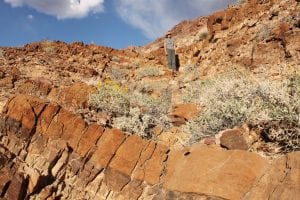Recently Taught Courses:
EPS 232: Earth-Surface Processes—This course provides an introduction to how we use Earth’s record (sedimentary rocks) to reconstruct environments, climate and life through Earth’s history. This course is grounded in discussion of the physical, chemical and biological processes that shape Earth’s landscapes today, and exploration of how study of these processes across various settings can be developed into tools to track Earth’s ancient history. Sedimentology and stratigraphy—the study of modern sediments and ancient sedimentary rock successions—allow us to recognize how environments on Earth’s surface—from mountains to deserts, lakes, rivers, glaciers, beaches, reefs and the deep sea—are products of these fundamental processes. Sedimentary rocks are also the primary repositories of Earth’s fossil, paleoclimate, paleoceanographic and biogeochemical records; study of the sedimentary rock record is therefore integral to interpreting how life, climate and the composition of the oceans and atmosphere have changed over our planet’s history. Moreover, sedimentology and stratigraphy also provide tools essential to gauging the habitability of other planetary bodies in our solar system and beyond. As paleoenvironmental archives, sedimentary rocks allow us to reconstruct how processes as disparate as the migration of tectonic plates, mountain-building, sea level change, climate change and the appearance and extinction of different groups of organisms have all shaped the evolution of Earth’s surface environments.
EPS 721: Topics in Geobiology—In this course, students survey recent papers and discuss emerging ideas concerning life-environment interactions through Earth’s history, with a particular focus on key intervals of biotic and environmental change preserved in the sedimentary record. In Fall 2021 and Fall 2022 this course focused on Neoproterozoic–lower Paleozoic paleontological, sedimentological and geochemical records bracketing the emergence of animal life and the dramatic environmental changes and significant radiations in multicellular life that have been inferred to have occurred during this interval—including the emergence and diversification of animals and animal-style ‘engineering’ ecologies, such as bioturbation, biomineralization and the emergence of new feeding strategies—and assess the evidence for driving mechanisms and causative relationships between these phenomena. In Fall 2023 Lidya will be co-teaching EPS 721 with recent EPS hire Jordan Wostbrock, and with a focus on the evolution of Earth’s silica cycle, from sedimentological and geochemical archives of past marine silica cycling to the radiation of silica biomineralizers, continental and marine pathways of silicate weathering and climate regulation, and diagenetic and high-temperature silica cycling.
EPS 620: Essentials of Earth and Planetary Sciences—This seminar provides a broad overview of fundamental topics in Earth and planetary sciences. For this course, Lidya has lectured on carbon and nutrient cycling, bioturbation and the evolution of the marine carbonate factory.
EPS 755, EPS 756: Seminar in Earth System Science—This seminar series is focused on building community in, as well as engaging students, postdocs, researchers and faculty in problems at the intersection of multiple components of the Earth system. This is a year-long seminar series and the course is annually organized around a central research topic. During the 2021-2022 academic year the research focus of the course has been the effect of heat waves (e.g., extreme and short-lived heat events) on life through Earth’s past, and investigating potential environmental and ecological changes indicated by recent and ongoing model projections of global warming in Earth’s future.
Field-Based Teaching Practices:
The Tarhan Lab endeavors to provide students with opportunities to gain practical experience in both the field and the laboratory, and to re-discover for themselves the fundamental properties of Earth’s building blocks. We pursue these objectives both by bringing students to the field—from the Great Basin, Death Valley, Rocky Mountain and Appalachian Basin regions of the USA to Canada, Australia, Spain, China and the Bahamas—and by bringing the field to the classroom, in the form of rock and fossil specimens.






Science Communication:
We also prioritize communication of our science to both the scientific community and the broader public, by assisting in the development of museum exhibits and working closely with journalists to produce press releases and news pieces that accurately and accessibly convey our research.
Selected News Coverage:
https://news.yale.edu/2023/02/22/insights-outcomes-clinical-trial-data-gaps-and-universe-old-milk
https://news.yale.edu/2021/09/27/no-soup-you-new-explanation-rise-ocean-animals
https://news.yale.edu/2021/05/27/revenge-seabed-burrowers
https://news.yale.edu/2018/08/01/ancient-sea-sediments-speak-no-big-bang-burrowers
https://news.yale.edu/2016/10/06/cementing-theory-about-sea-creatures-ediacara-biota
https://news.yale.edu/2015/09/28/ancient-dirt-churners-took-their-time-stirring-ocean-floor
http://www.sciencemag.org/news/2016/10/how-earth-s-oldest-animals-were-fossilized